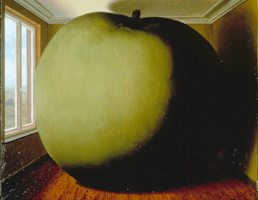The Listening Room
The Listening Room is a seminal work of art by the Belgian surrealist artist René Magritte. Created in 1952, this painting is a striking example of Magritte's fascination with the ordinary objects placed in unusual contexts, challenging observers' preconceived notions of reality and perception. The artwork features a simple green apple occupying a room, disproportionately large compared to the size of the room's walls, suggesting a surreal distortion of scale and space.
Description[edit | edit source]
In The Listening Room, Magritte presents a large green apple situated in the center of a room. The apple almost touches the room's walls, ceiling, and floor, leaving only a small gap between its outline and the room's boundaries. This depiction plays with the viewer's sense of space and the relationship between objects and their surroundings. The room has a simplicity to it, with minimal detailing, which draws more attention to the apple's exaggerated size. The use of color is also notable; the green of the apple contrasts with the muted tones of the room, making the apple even more prominent.
Themes and Interpretation[edit | edit source]
Magritte's work often explores the tension between reality and illusion, and The Listening Room is no exception. By altering the scale of a familiar object, Magritte invites viewers to question their perceptions and the conventions of seeing. The title itself, The Listening Room, suggests a sensory shift from visual to auditory, adding another layer of surreal experience. It implies that objects, like the oversized apple, have their own sounds, stories, or secrets, further blurring the lines between the senses and perceptions.
The painting can be interpreted in various ways, reflecting Magritte's intention to provoke thought rather than convey a specific message. Some see it as a commentary on the intrusion of nature into human-made spaces, while others view it as a playful manipulation of reality, typical of surrealist art. The juxtaposition of the ordinary with the extraordinary creates a dream-like atmosphere, a hallmark of Magritte's artistic style.
Legacy[edit | edit source]
The Listening Room has had a significant impact on both the surrealist movement and contemporary art. Its influence can be seen in the works of later artists who explore similar themes of scale, space, and the surreal nature of everyday objects. The painting is often discussed in the context of Magritte's broader oeuvre, which includes other iconic works such as The Treachery of Images and The Son of Man.
Magritte's ability to transform the mundane into the extraordinary has made The Listening Room a lasting symbol of surrealism's power to alter perceptions and challenge the boundaries of reality. The painting is frequently featured in art history texts and exhibitions dedicated to surrealism, attesting to its enduring relevance and appeal.
See Also[edit | edit source]
Search WikiMD
Ad.Tired of being Overweight? Try W8MD's physician weight loss program.
Semaglutide (Ozempic / Wegovy and Tirzepatide (Mounjaro / Zepbound) available.
Advertise on WikiMD
|
WikiMD's Wellness Encyclopedia |
| Let Food Be Thy Medicine Medicine Thy Food - Hippocrates |
Translate this page: - East Asian
中文,
日本,
한국어,
South Asian
हिन्दी,
தமிழ்,
తెలుగు,
Urdu,
ಕನ್ನಡ,
Southeast Asian
Indonesian,
Vietnamese,
Thai,
မြန်မာဘာသာ,
বাংলা
European
español,
Deutsch,
français,
Greek,
português do Brasil,
polski,
română,
русский,
Nederlands,
norsk,
svenska,
suomi,
Italian
Middle Eastern & African
عربى,
Turkish,
Persian,
Hebrew,
Afrikaans,
isiZulu,
Kiswahili,
Other
Bulgarian,
Hungarian,
Czech,
Swedish,
മലയാളം,
मराठी,
ਪੰਜਾਬੀ,
ગુજરાતી,
Portuguese,
Ukrainian
Medical Disclaimer: WikiMD is not a substitute for professional medical advice. The information on WikiMD is provided as an information resource only, may be incorrect, outdated or misleading, and is not to be used or relied on for any diagnostic or treatment purposes. Please consult your health care provider before making any healthcare decisions or for guidance about a specific medical condition. WikiMD expressly disclaims responsibility, and shall have no liability, for any damages, loss, injury, or liability whatsoever suffered as a result of your reliance on the information contained in this site. By visiting this site you agree to the foregoing terms and conditions, which may from time to time be changed or supplemented by WikiMD. If you do not agree to the foregoing terms and conditions, you should not enter or use this site. See full disclaimer.
Credits:Most images are courtesy of Wikimedia commons, and templates Wikipedia, licensed under CC BY SA or similar.
Contributors: Prab R. Tumpati, MD

